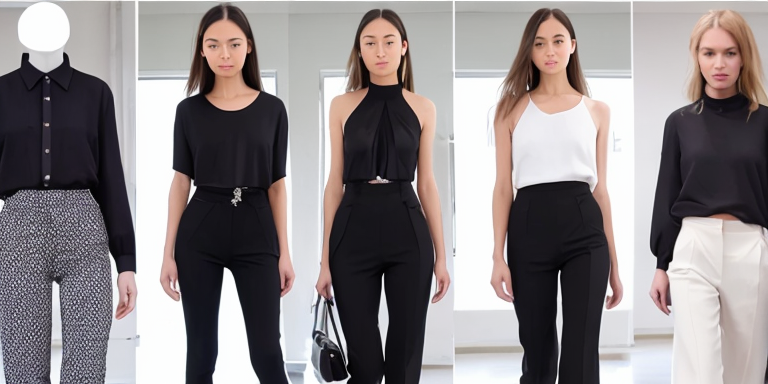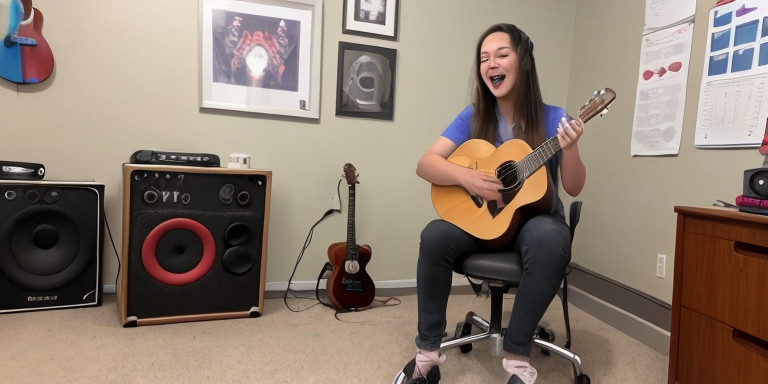The Fashion industry has been significantly impacted by the COVID-19 pandemic. The pandemic has caused a shift in consumer behavior, with many people opting for comfortable and practical clothing over formal and fashionable attire. As a result, the fashion industry has experienced a decline in sales, with many fashion brands struggling to stay afloat.
The pandemic has also led to the cancellation of many fashion events, including fashion weeks and runway shows. These events are crucial for the industry as they provide a platform for designers to showcase their latest collections to potential buyers and the media. Without these events, many designers have been left with limited opportunities to showcase their work.
However, the pandemic has also led to the rise of remote work in the fashion industry. With many fashion companies forced to close their physical offices, designers and other industry professionals have had to adapt to working from home. This shift has led to the development of new and innovative ways of working that have allowed the industry to continue functioning.
One of the ways the fashion industry has adapted to remote work is through virtual runway shows and fashion weeks. Designers have been able to showcase their collections through live streams and pre-recorded videos, allowing them to reach a wider audience than ever before. This approach has also allowed designers to save on the costs associated with hosting physical events.
Another way the fashion industry has adapted to remote work is through digital product launches and online showrooms. With physical stores closed or operating at limited capacity, many fashion brands have had to shift their focus to online sales. This shift has led to the development of new and innovative ways of presenting products online, such as virtual showrooms and 3D product displays.
Communication and collaboration tools have also played a crucial role in the fashion industry’s shift to remote work. With designers and other industry professionals working from home, it has become essential to have effective communication and collaboration tools in place. Tools such as Zoom, Slack, and Trello have allowed designers to collaborate remotely, ensuring that projects are completed on time and to a high standard.
While remote work has provided a solution to some of the challenges faced by the fashion industry during the pandemic, it has also presented its own set of challenges. One of the main challenges of remote work in the fashion industry is the difficulty of collaborating and communicating effectively. With designers and other industry professionals working from different locations, it can be challenging to ensure that everyone is on the same page.
Another challenge of remote work in the fashion industry is the lack of physical interaction with products. Designers often rely on physical samples and prototypes to make design decisions, but with remote work, this can be challenging. While 3D product displays and virtual showrooms have helped to address this issue, they cannot fully replace physical samples.
Despite these challenges, remote work has provided many benefits for fashion designers. One of the main benefits is increased flexibility and work-life balance. With designers able to work from home, they have more control over their schedules, allowing them to balance work and personal commitments more effectively.
Remote work in the fashion industry has also provided environmental benefits, with reduced carbon footprints resulting from fewer physical events and reduced travel. This shift towards remote work has the potential to have a long-term impact on the industry, with many experts predicting that it will become a permanent feature of the fashion industry.
In conclusion, the COVID-19 pandemic has had a significant impact on the fashion industry, leading to the rise of remote work. While remote work has presented its own set of challenges, it has also provided solutions to some of the challenges faced by the industry. The future of remote work in the fashion industry is promising, with many experts predicting that it will become a permanent feature of the industry.
Adapting to Remote Work: The Fashion Industry’s Response to COVID-19
The COVID-19 pandemic has forced many industries to adapt to remote work, and the fashion industry is no exception. With in-person events and meetings canceled or postponed, designers have had to find new ways to showcase their work and collaborate with others. One of the most notable adaptations has been the rise of virtual runway shows and fashion weeks.
Designers like Uvanni have been able to successfully showcase their collections through digital platforms, allowing them to reach a wider audience than ever before. These virtual events have also been more accessible to consumers, who can now view the shows from the comfort of their own homes.
In addition to virtual events, designers have also turned to digital product launches and online showrooms to showcase their work. These platforms have allowed designers to connect with buyers and consumers from around the world, without the need for in-person meetings or events.
To facilitate remote collaboration and communication, designers have also turned to a variety of tools and technologies. Video conferencing platforms like Zoom and Skype have allowed designers to connect with each other and with clients, while project management tools like Trello and Asana have enabled them to stay organized and on track.
While remote work has certainly presented its challenges, there have also been many benefits for fashion designers. One of the most notable benefits has been increased flexibility and work-life balance. Designers are now able to work from anywhere, at any time, allowing them to better balance work and personal commitments.
Remote work has also had a positive impact on the environment, with reduced travel and transportation resulting in a lower carbon footprint. This has been a particularly important consideration for the fashion industry, which has traditionally been criticized for its environmental impact.
However, remote work has also presented its challenges, particularly when it comes to collaboration and communication. Designers have had to find new ways to work together, often relying on digital tools and technologies to facilitate communication and feedback.
Looking to the future, many experts predict that remote work will continue to play a significant role in the fashion industry. However, there are also concerns about the long-term impact of remote work on the industry, particularly when it comes to the development of new talent.
Some designers have already begun to explore hybrid work models, which combine remote work with in-person collaboration and events. These models may offer the best of both worlds, allowing designers to enjoy the benefits of remote work while still maintaining the personal connections and interactions that are so important in the fashion industry.
In conclusion, the fashion industry has adapted to remote work in a variety of ways, from virtual runway shows to online collaboration tools. While there have certainly been challenges, there have also been many benefits, including increased flexibility and a reduced environmental impact. As the industry looks to the future, it will be interesting to see how remote work continues to evolve and shape the fashion landscape.
The Pros and Cons of Remote Work for Fashion Designers
The COVID-19 pandemic has forced the fashion industry to adapt to remote work, and many designers have found it to be both a blessing and a curse. On the one hand, remote work has provided increased flexibility and work-life balance for designers who can now work from anywhere in the world. On the other hand, remote work has also presented challenges in terms of collaboration and communication.
One fashion designer who has successfully adapted to remote work is Uvanni. Uvanni has been able to showcase his designs through virtual runway shows and online showrooms, which have allowed him to reach a wider audience than ever before. However, Uvanni has also had to adjust to the challenges of remote collaboration and communication, which can be difficult when working with a team of designers and other professionals.
One challenge of remote work for fashion designers is the lack of face-to-face interaction. Designers often rely on nonverbal cues and in-person meetings to communicate their ideas effectively. With remote work, designers must rely on digital communication tools such as video conferencing and instant messaging, which can be less effective in conveying complex ideas.
Another challenge of remote work for fashion designers is the lack of access to physical samples and materials. Designers often need to touch and feel fabrics and other materials to ensure they are of the highest quality. With remote work, designers must rely on digital images and descriptions, which can be less accurate and reliable.
Despite these challenges, remote work has also provided several benefits for fashion designers. For example, remote work has reduced the carbon footprint of the fashion industry by eliminating the need for designers to travel to physical locations for meetings and events. Remote work has also provided increased flexibility and work-life balance for designers who can now work from anywhere in the world.
In the future, remote work is likely to continue to play a significant role in the fashion industry. Experts predict that hybrid work models, which combine remote work and in-person collaboration, will become increasingly popular. These models will allow designers to enjoy the benefits of remote work while still maintaining the face-to-face interaction necessary for effective collaboration.
In conclusion, remote work has both advantages and disadvantages for fashion designers. While it provides increased flexibility and work-life balance, it also presents challenges in terms of collaboration and communication. As the fashion industry continues to adapt to remote work, designers will need to find new ways to collaborate effectively and communicate their ideas.
The Future of Remote Work in Fashion: Expert Opinions and Hybrid Models
As the fashion industry continues to adapt to the challenges posed by the COVID-19 pandemic, remote work has emerged as a viable solution for many fashion designers and industry professionals. While remote work has its challenges, it also presents numerous opportunities for increased flexibility, reduced environmental impact, and improved work-life balance. But what does the future of remote work in fashion look like?
According to fashion designer Uvanni, remote work has been a game-changer for his business. “Before the pandemic, I never would have considered remote work as a viable option for my team,” he explains. “But now, I see the potential for increased collaboration and creativity that remote work can bring.”
Other fashion industry experts agree that remote work is here to stay. “I think we’ll see a lot more remote work in the fashion industry in the future,” says Judge Smith, a fashion industry analyst. “It’s just too convenient and cost-effective to ignore.”
But what will remote work in fashion look like in the long term? Some experts predict a shift towards hybrid work models, where designers and industry professionals split their time between remote work and in-person collaboration. This approach offers the best of both worlds: the flexibility and convenience of remote work, combined with the benefits of in-person collaboration and communication.
Of course, there are still challenges to be addressed when it comes to remote work in fashion. Communication and collaboration can be difficult when working remotely, and there is a risk of decreased creativity and innovation without in-person interaction. However, these challenges can be overcome with the right tools and strategies.
One potential solution is to invest in communication and collaboration tools specifically designed for remote work in the fashion industry. These tools can help designers and industry professionals stay connected and engaged, even when working from different locations.
Another approach is to prioritize in-person collaboration for certain aspects of the design process, while allowing for remote work in other areas. For example, designers could gather in person for brainstorming sessions and creative workshops, while completing individual design work remotely.
Overall, the future of remote work in fashion looks bright. By embracing new technologies and hybrid work models, the industry can continue to thrive and adapt to the challenges of the modern world. As Uvanni puts it, Remote work has opened up a whole new world of possibilities for us as designers. I’m excited to see where it takes us in the future.”
The Future of Remote Work in Fashion
The COVID-19 pandemic has accelerated the adoption of remote work in the fashion industry. As designers, models, and other industry professionals have been forced to work from home, they have had to adapt to new ways of collaborating and communicating. While remote work has presented its challenges, it has also opened up new opportunities for the industry.
As we look to the future of remote work in fashion, it’s clear that it will continue to play a significant role in the industry. Many experts predict that even after the pandemic subsides, remote work will remain a key part of the fashion industry’s operations. This is due to several factors, including the benefits of hybrid work models and the potential long-term impact of remote work on the industry.
One of the most significant benefits of hybrid work models is that they can address some of the challenges of remote collaboration and communication. Hybrid work models allow employees to work both remotely and in-person, which can help to bridge the gap between remote and in-person teams. This can help to improve communication and collaboration, as well as foster a sense of community and belonging among team members.
In addition to the benefits of hybrid work models, remote work also has the potential to have a long-term impact on the fashion industry. For example, remote work can help to reduce the industry’s carbon footprint by reducing the need for travel and in-person events. This can help to make the industry more sustainable and environmentally friendly.
Furthermore, remote work can also help to democratize the fashion industry by making it more accessible to people from diverse backgrounds. Remote work can help to break down barriers to entry by allowing people to work from anywhere in the world, regardless of their location or socioeconomic status.
However, remote work also presents its challenges. One of the biggest challenges is the lack of face-to-face interaction, which can make it difficult to build relationships and foster a sense of community among team members. Additionally, remote work can make it more difficult to collaborate on creative projects, as it can be harder to share ideas and provide feedback in a virtual environment.
Despite these challenges, the future of remote work in fashion looks bright. As the industry continues to adapt to new ways of working, we can expect to see new and innovative approaches to collaboration and communication. Whether it’s through hybrid work models or other solutions, remote work is here to stay in the fashion industry.
Final Thoughts on the Future of Remote Work in the Industry
In conclusion, the rise of remote work in the fashion industry has been a significant development over the past year. While it has presented its challenges, it has also opened up new opportunities for the industry. As we look to the future, it’s clear that remote work will continue to play a significant role in the industry’s operations. Whether it’s through hybrid work models or other solutions, remote work has the potential to make the fashion industry more sustainable, accessible, and innovative.









